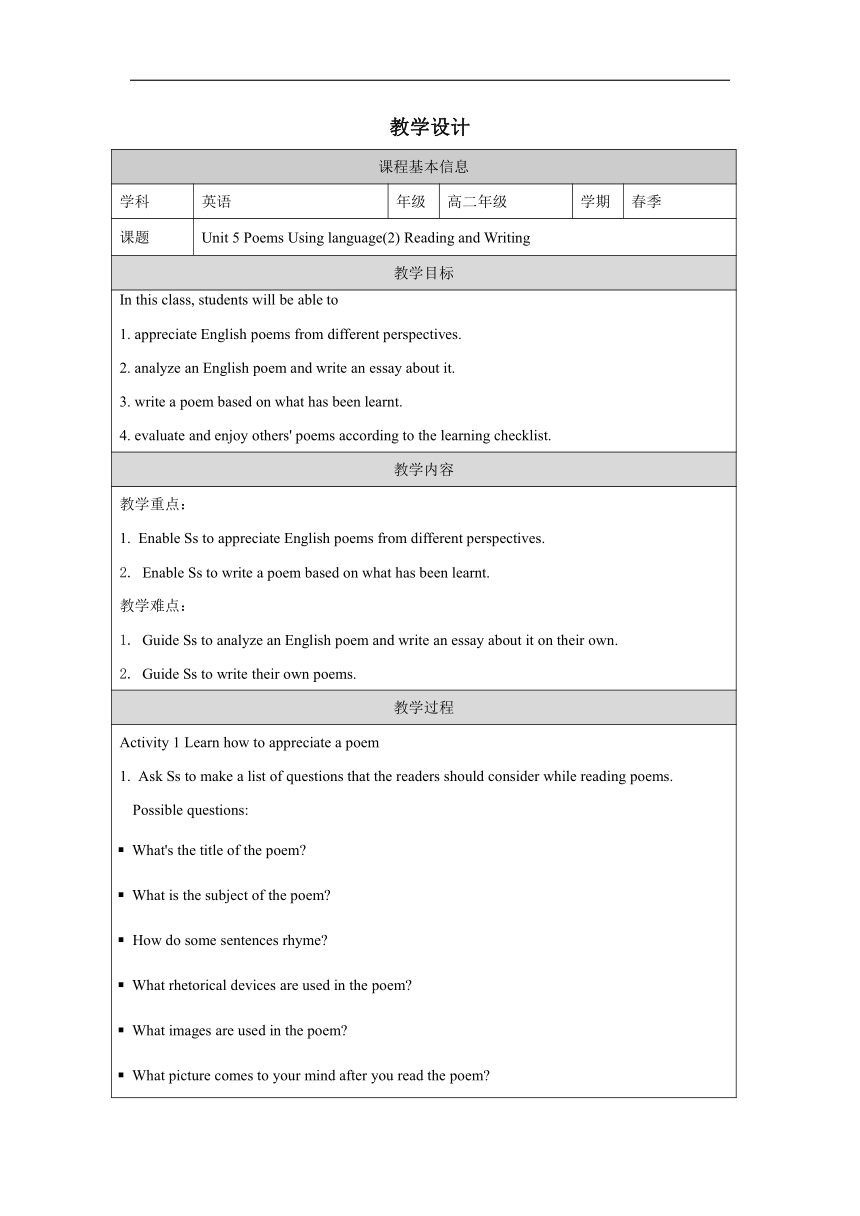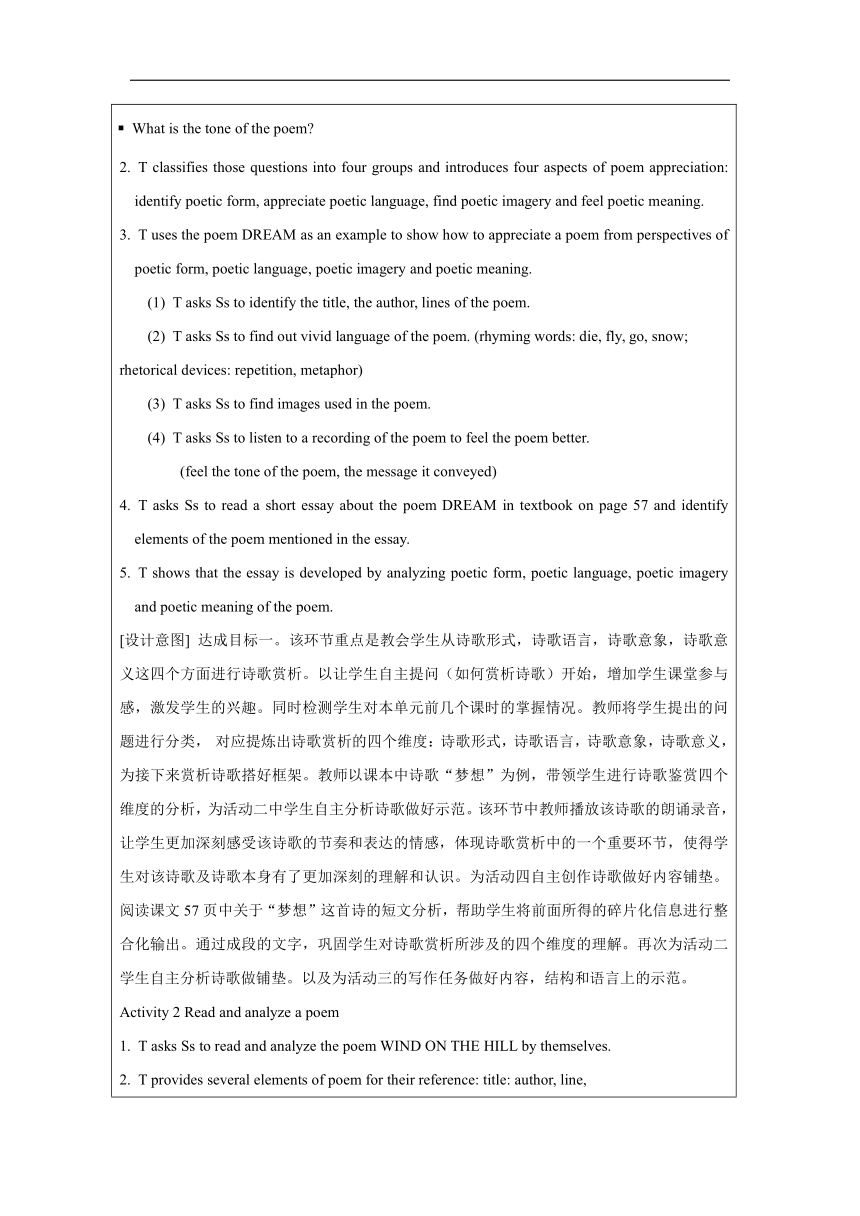人教版(2019)选择性必修第三册 Unit 5 Poems Using Language(2)_ Reading and Writing-教学设计(表格式)
文档属性
| 名称 | 人教版(2019)选择性必修第三册 Unit 5 Poems Using Language(2)_ Reading and Writing-教学设计(表格式) |  | |
| 格式 | docx | ||
| 文件大小 | 204.4KB | ||
| 资源类型 | 教案 | ||
| 版本资源 | 人教版(2019) | ||
| 科目 | 英语 | ||
| 更新时间 | 2024-04-07 22:05:37 | ||
图片预览


文档简介
教学设计
课程基本信息
学科 英语 年级 高二年级 学期 春季
课题 Unit 5 Poems Using language(2) Reading and Writing
教学目标
In this class, students will be able to 1. appreciate English poems from different perspectives. 2. analyze an English poem and write an essay about it. 3. write a poem based on what has been learnt. 4. evaluate and enjoy others' poems according to the learning checklist.
教学内容
教学重点: Enable Ss to appreciate English poems from different perspectives. Enable Ss to write a poem based on what has been learnt.
教学难点: Guide Ss to analyze an English poem and write an essay about it on their own. Guide Ss to write their own poems.
教学过程
Activity 1 Learn how to appreciate a poem Ask Ss to make a list of questions that the readers should consider while reading poems. P Possible questions: What's the title of the poem What is the subject of the poem How do some sentences rhyme What rhetorical devices are used in the poem What images are used in the poem What picture comes to your mind after you read the poem What is the tone of the poem T classifies those questions into four groups and introduces four aspects of poem appreciation: identify poetic form, appreciate poetic language, find poetic imagery and feel poetic meaning. T uses the poem DREAM as an example to show how to appreciate a poem from perspectives of poetic form, poetic language, poetic imagery and poetic meaning. T asks Ss to identify the title, the author, lines of the poem. T asks Ss to find out vivid language of the poem. (rhyming words: die, fly, go, snow; rhetorical devices: repetition, metaphor) T asks Ss to find images used in the poem. T asks Ss to listen to a recording of the poem to feel the poem better. (feel the tone of the poem, the message it conveyed) T asks Ss to read a short essay about the poem DREAM in textbook on page 57 and identify elements of the poem mentioned in the essay. T shows that the essay is developed by analyzing poetic form, poetic language, poetic imagery and poetic meaning of the poem. [设计意图] 达成目标一。该环节重点是教会学生从诗歌形式,诗歌语言,诗歌意象,诗歌意义这四个方面进行诗歌赏析。以让学生自主提问(如何赏析诗歌)开始,增加学生课堂参与感,激发学生的兴趣。同时检测学生对本单元前几个课时的掌握情况。教师将学生提出的问题进行分类, 对应提炼出诗歌赏析的四个维度:诗歌形式,诗歌语言,诗歌意象,诗歌意义,为接下来赏析诗歌搭好框架。教师以课本中诗歌“梦想”为例,带领学生进行诗歌鉴赏四个维度的分析,为活动二中学生自主分析诗歌做好示范。该环节中教师播放该诗歌的朗诵录音,让学生更加深刻感受该诗歌的节奏和表达的情感,体现诗歌赏析中的一个重要环节,使得学生对该诗歌及诗歌本身有了更加深刻的理解和认识。为活动四自主创作诗歌做好内容铺垫。阅读课文57页中关于“梦想”这首诗的短文分析,帮助学生将前面所得的碎片化信息进行整合化输出。通过成段的文字,巩固学生对诗歌赏析所涉及的四个维度的理解。再次为活动二学生自主分析诗歌做铺垫。以及为活动三的写作任务做好内容,结构和语言上的示范。 Activity 2 Read and analyze a poem T asks Ss to read and analyze the poem WIND ON THE HILL by themselves. T provides several elements of poem for their reference: title: author, line, rhyming words, rhetorical devices, images, subject, tone, feelings. T asks Ss to listen to a recording of the poem to feel the poem better. [设计意图] 为达成目标二。本环节全程由学生自主完成,体现学生为主体及课堂的自主性。经过Activity 1 中五个环节的指导,学生对如何进行诗歌赏析有了一定的理解,在该环节中加以应用。该课时是本单元的第五课时。经过前几个课时关于诗歌形式,诗歌修辞等的学习,在该课时中学生具备相关知识和语言能力独立完成诗歌赏析。此外,高二的学生,拥有较高思维品质,为独立赏析诗歌创造条件。 Activity 3 Write a short essay about a poem T asks Ss to organize their analyses about the poem into an essay by following the example in textbook on page 57. T provides essay structure and more useful expressions for their reference. T asks Ss to present their essays to the class. (T presents one essay from her student.) [设计意图] 为达成目标二。让学生将自己对该诗歌的赏析整理成文,是零散信息走向整合表达的过程,是知识结构化的过程。学生通过成段文字的输出,对诗歌这种文学形式有了更加深刻的认识,同时积累诗歌创作素材,为活动四自主创作诗歌做好铺垫。教师提供文章结构和语言支撑,为学生写作搭好脚手架,保证教学环节顺利进行。 Activity 4 Write a poem 1. T asks Ss to think about how to write a poem. 2. T shows five steps(corresponding to four aspects of the poem) to write a poem. 3. T shows an example of writing a poem step by step. 4. Ss write their own poems step by step. Step 1: What message do you want to give to the reader What is important to you Theme: Feelings/ emotions: Step 2: Make a list of words related to your theme. Rhyming words: Descriptive words: Step 3: Check how well your details paint a picture in your mind. Images: Rhetorical devices: Picture painted: Step 4: Read the poem aloud and listen to how it sounds. Step 5: Give it a title and your poem is ready. [设计意图] 达成目标三。让学生回答如何创作诗歌,旨在让学生梳理学过的知识,通过自己思考,形成创作期待。教师给出创作诗歌的五个步骤,为学生的创作搭建脚手架的同时,引导学生从创作的角度进一步理解诗歌形式,诗歌语言,诗歌意象和诗歌意义。教师以一位学生创作诗歌的过程为例,逐步向学生展示一首诗歌从立意,选词,构造意象,感受语调到拟定标题的全部环节,为后续学生自主创作提供可视性化模板。 Activity 5 Evaluate and enjoy others' poems T invites several Ss to read out their poems in front of class. (T presents one poem from her student.) T shows the learning checklist (corresponding to four aspects of the poem) to Ss. T, together with Ss, evaluates and enjoys the poem she presents according to the learning checklist. [设计意图] 达成目标四。让学生大声读出自己创作的诗歌可以更好地表达其作品的感情,同时给到学生丰富体验,增加自信。明确诗歌的评价项目,让学生对照评价项目,对同伴创作的诗歌进行评价,同时再次渗透关注诗歌四个维度的意识。实现从赏析到创作到评价使用一个标准。即一个标准贯穿一整节课。 Activity 6 Assingnment 1. Work in groups, evaluate and enjoy others' poems according to the learning checklist and polish your poems based on others' advice . Write a short essay about the poem A MATCH on page 56. [设计意图] 作业一深化学生对诗歌评价项目的认识, 结合诗歌四个维度产出高质量原创诗歌。作业二为整合性输出诗歌赏析短文提供更多操练机会。
课程基本信息
学科 英语 年级 高二年级 学期 春季
课题 Unit 5 Poems Using language(2) Reading and Writing
教学目标
In this class, students will be able to 1. appreciate English poems from different perspectives. 2. analyze an English poem and write an essay about it. 3. write a poem based on what has been learnt. 4. evaluate and enjoy others' poems according to the learning checklist.
教学内容
教学重点: Enable Ss to appreciate English poems from different perspectives. Enable Ss to write a poem based on what has been learnt.
教学难点: Guide Ss to analyze an English poem and write an essay about it on their own. Guide Ss to write their own poems.
教学过程
Activity 1 Learn how to appreciate a poem Ask Ss to make a list of questions that the readers should consider while reading poems. P Possible questions: What's the title of the poem What is the subject of the poem How do some sentences rhyme What rhetorical devices are used in the poem What images are used in the poem What picture comes to your mind after you read the poem What is the tone of the poem T classifies those questions into four groups and introduces four aspects of poem appreciation: identify poetic form, appreciate poetic language, find poetic imagery and feel poetic meaning. T uses the poem DREAM as an example to show how to appreciate a poem from perspectives of poetic form, poetic language, poetic imagery and poetic meaning. T asks Ss to identify the title, the author, lines of the poem. T asks Ss to find out vivid language of the poem. (rhyming words: die, fly, go, snow; rhetorical devices: repetition, metaphor) T asks Ss to find images used in the poem. T asks Ss to listen to a recording of the poem to feel the poem better. (feel the tone of the poem, the message it conveyed) T asks Ss to read a short essay about the poem DREAM in textbook on page 57 and identify elements of the poem mentioned in the essay. T shows that the essay is developed by analyzing poetic form, poetic language, poetic imagery and poetic meaning of the poem. [设计意图] 达成目标一。该环节重点是教会学生从诗歌形式,诗歌语言,诗歌意象,诗歌意义这四个方面进行诗歌赏析。以让学生自主提问(如何赏析诗歌)开始,增加学生课堂参与感,激发学生的兴趣。同时检测学生对本单元前几个课时的掌握情况。教师将学生提出的问题进行分类, 对应提炼出诗歌赏析的四个维度:诗歌形式,诗歌语言,诗歌意象,诗歌意义,为接下来赏析诗歌搭好框架。教师以课本中诗歌“梦想”为例,带领学生进行诗歌鉴赏四个维度的分析,为活动二中学生自主分析诗歌做好示范。该环节中教师播放该诗歌的朗诵录音,让学生更加深刻感受该诗歌的节奏和表达的情感,体现诗歌赏析中的一个重要环节,使得学生对该诗歌及诗歌本身有了更加深刻的理解和认识。为活动四自主创作诗歌做好内容铺垫。阅读课文57页中关于“梦想”这首诗的短文分析,帮助学生将前面所得的碎片化信息进行整合化输出。通过成段的文字,巩固学生对诗歌赏析所涉及的四个维度的理解。再次为活动二学生自主分析诗歌做铺垫。以及为活动三的写作任务做好内容,结构和语言上的示范。 Activity 2 Read and analyze a poem T asks Ss to read and analyze the poem WIND ON THE HILL by themselves. T provides several elements of poem for their reference: title: author, line, rhyming words, rhetorical devices, images, subject, tone, feelings. T asks Ss to listen to a recording of the poem to feel the poem better. [设计意图] 为达成目标二。本环节全程由学生自主完成,体现学生为主体及课堂的自主性。经过Activity 1 中五个环节的指导,学生对如何进行诗歌赏析有了一定的理解,在该环节中加以应用。该课时是本单元的第五课时。经过前几个课时关于诗歌形式,诗歌修辞等的学习,在该课时中学生具备相关知识和语言能力独立完成诗歌赏析。此外,高二的学生,拥有较高思维品质,为独立赏析诗歌创造条件。 Activity 3 Write a short essay about a poem T asks Ss to organize their analyses about the poem into an essay by following the example in textbook on page 57. T provides essay structure and more useful expressions for their reference. T asks Ss to present their essays to the class. (T presents one essay from her student.) [设计意图] 为达成目标二。让学生将自己对该诗歌的赏析整理成文,是零散信息走向整合表达的过程,是知识结构化的过程。学生通过成段文字的输出,对诗歌这种文学形式有了更加深刻的认识,同时积累诗歌创作素材,为活动四自主创作诗歌做好铺垫。教师提供文章结构和语言支撑,为学生写作搭好脚手架,保证教学环节顺利进行。 Activity 4 Write a poem 1. T asks Ss to think about how to write a poem. 2. T shows five steps(corresponding to four aspects of the poem) to write a poem. 3. T shows an example of writing a poem step by step. 4. Ss write their own poems step by step. Step 1: What message do you want to give to the reader What is important to you Theme: Feelings/ emotions: Step 2: Make a list of words related to your theme. Rhyming words: Descriptive words: Step 3: Check how well your details paint a picture in your mind. Images: Rhetorical devices: Picture painted: Step 4: Read the poem aloud and listen to how it sounds. Step 5: Give it a title and your poem is ready. [设计意图] 达成目标三。让学生回答如何创作诗歌,旨在让学生梳理学过的知识,通过自己思考,形成创作期待。教师给出创作诗歌的五个步骤,为学生的创作搭建脚手架的同时,引导学生从创作的角度进一步理解诗歌形式,诗歌语言,诗歌意象和诗歌意义。教师以一位学生创作诗歌的过程为例,逐步向学生展示一首诗歌从立意,选词,构造意象,感受语调到拟定标题的全部环节,为后续学生自主创作提供可视性化模板。 Activity 5 Evaluate and enjoy others' poems T invites several Ss to read out their poems in front of class. (T presents one poem from her student.) T shows the learning checklist (corresponding to four aspects of the poem) to Ss. T, together with Ss, evaluates and enjoys the poem she presents according to the learning checklist. [设计意图] 达成目标四。让学生大声读出自己创作的诗歌可以更好地表达其作品的感情,同时给到学生丰富体验,增加自信。明确诗歌的评价项目,让学生对照评价项目,对同伴创作的诗歌进行评价,同时再次渗透关注诗歌四个维度的意识。实现从赏析到创作到评价使用一个标准。即一个标准贯穿一整节课。 Activity 6 Assingnment 1. Work in groups, evaluate and enjoy others' poems according to the learning checklist and polish your poems based on others' advice . Write a short essay about the poem A MATCH on page 56. [设计意图] 作业一深化学生对诗歌评价项目的认识, 结合诗歌四个维度产出高质量原创诗歌。作业二为整合性输出诗歌赏析短文提供更多操练机会。
